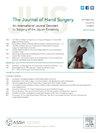The Green Transfer—Long-Term Results
IF 2.1
2区 医学
Q2 ORTHOPEDICS
引用次数: 0
Abstract
Purpose
The purpose of this study was to determine the long-term results of the Green transfer (flexor carpi ulnaris to extensor carpi radialis brevis) for patient-reported outcomes, wrist position, and range of motion.
Methods
We re-examined 13 patients from a previous prospective study involving surgery for hemiplegia that included a Green transfer. The average follow-up was 8 years with the range from 5 to 11 years. The wrist range of motion and the postoperative position of the wrists were measured. The surgical outcomes were measured via the Pediatric Orthopedic Data Collection Instrument, the Shriner’s Hospital Upper Extremity Evaluation, Pediatric Quality of Life, and visual analog score for appearance from the patient and the parent.
Results
At this follow-up, only 7 of the 13 patients had a wrist position near neutral with the ability to flex and extend the wrist. Wrist range of motion was improved in four, decreased in four, and stayed the same in five patients. In contrast to these positional wrist results, statistically significant improvements were noted in several aspects of the Pediatric Orthopedic Data Collection Instrument, visual analog scores, and Shriner’s Hospital Upper Extremity Evaluation scores.
Conclusions
Long-term follow-up of the flexor carpi ulnaris to extensor carpi radialis brevis tendon transfer in hemiplegic patients reveals the results to be variable but favorable from a patient-reported outcome standpoint.
Type of study/level of evidence
Therapeutic IV.
绿色转移——长期结果。
目的:本研究的目的是确定Green转移(尺侧腕屈肌到桡侧腕短伸肌)对患者报告的预后、手腕位置和活动范围的长期效果。方法:我们重新检查了先前一项前瞻性研究中的13例偏瘫手术患者,其中包括格林转移。平均随访8年,随访时间从5年到11年不等。测量腕关节活动度及术后腕关节位置。手术结果通过儿童骨科数据收集仪、Shriner医院上肢评估、儿童生活质量和患者和父母的视觉模拟外观评分来测量。结果:在这次随访中,13例患者中只有7例手腕位置接近中性,有屈伸手腕的能力。4名患者的手腕活动范围得到改善,4名患者的手腕活动范围减少,5名患者的手腕活动范围保持不变。与这些手腕位置的结果相比,在儿童骨科数据收集仪器、视觉模拟评分和Shriner医院上肢评估评分的几个方面都有统计学上显著的改善。结论:对偏瘫患者进行尺侧腕屈肌到桡侧腕短伸肌肌腱移植的长期随访显示,结果是可变的,但从患者报告的结果来看是有利的。研究类型/证据水平:治疗性IV。
本文章由计算机程序翻译,如有差异,请以英文原文为准。
求助全文
约1分钟内获得全文
求助全文
来源期刊
CiteScore
3.20
自引率
10.50%
发文量
402
审稿时长
12 weeks
期刊介绍:
The Journal of Hand Surgery publishes original, peer-reviewed articles related to the pathophysiology, diagnosis, and treatment of diseases and conditions of the upper extremity; these include both clinical and basic science studies, along with case reports. Special features include Review Articles (including Current Concepts and The Hand Surgery Landscape), Reviews of Books and Media, and Letters to the Editor.

 求助内容:
求助内容: 应助结果提醒方式:
应助结果提醒方式:


